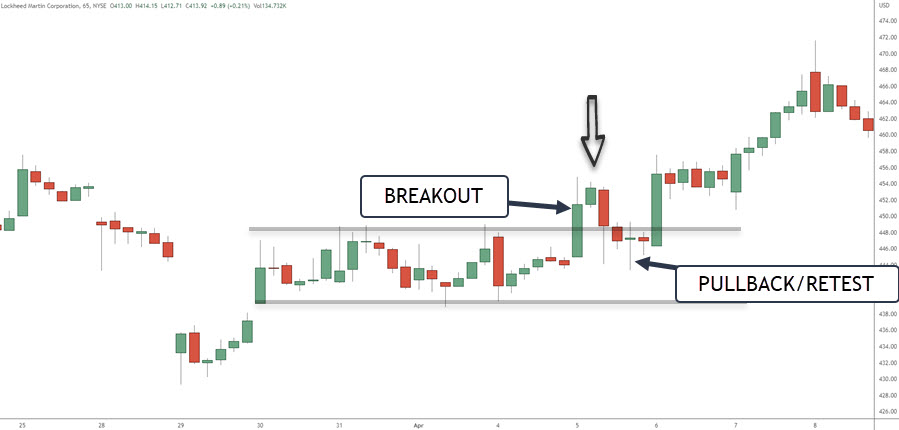- July 31, 2022
- Posted by: Shane Daly
- Category: Trading Article

Horizontal channels, not to be confused with trend channels, are a powerful chart pattern that can be used for swing trading stocks. Being simple to identify on many time frames makes them a viable chart pattern for all traders to use.
With easy to define entry and exit points, we are going to cover what the channels are, how they form, and several methods you can use to trade them.
What Is A Horizontal Channel?
A horizontal channel is a chart pattern that is created when price action of an asset moves between two parallel support and resistance levels. This pattern can be used to trade both bullish and bearish trends and forms during during periods of indecision and uncertainty.
 The main benefit of using horizontal channels is that they provide traders with clear entry and exit points. In addition, this pattern can be used to trade both long and short positions.
The main benefit of using horizontal channels is that they provide traders with clear entry and exit points. In addition, this pattern can be used to trade both long and short positions.
Why Use Channels For Swing Trading Stocks?
There are several reasons why you may want to consider using horizontal channels for swing trading stocks.
First, as mentioned earlier, this chart pattern can provide you with clear entry and exit points. Both the high and low boundary offers excellent trading locations. This can be extremely helpful in managing your risk and having a defined entry zone.
In addition, horizontal channels tend to be relatively reliable patterns. This means that they can be a useful tool for identifying potential swing trading opportunities when the pattern resolves. During these channels, we get a volatility compression. Once the pattern breaks and confirms, you could be on your way to some healthy runs in price.
Another reason to consider using horizontal channels for swing trading stocks is that they can be used to trade both long and short positions. This flexibility can be extremely helpful in quickly adapting to changing market conditions.
Finally, horizontal channels tend to form relatively frequently. This means that if you know how to identify and trade them, you can potentially find a number of profitable trading opportunities.
How To Identify Horizontal Channels
There are a few things to look for when trying to identify horizontal channels in stocks.
First, you want to look for a stock that is trading between two well-defined support and resistance levels. These should be parallel lines although there will be times when price splashes outside either high or low zone. Just ensure that your lines cover the bulk of trading activity at the high and low zones.
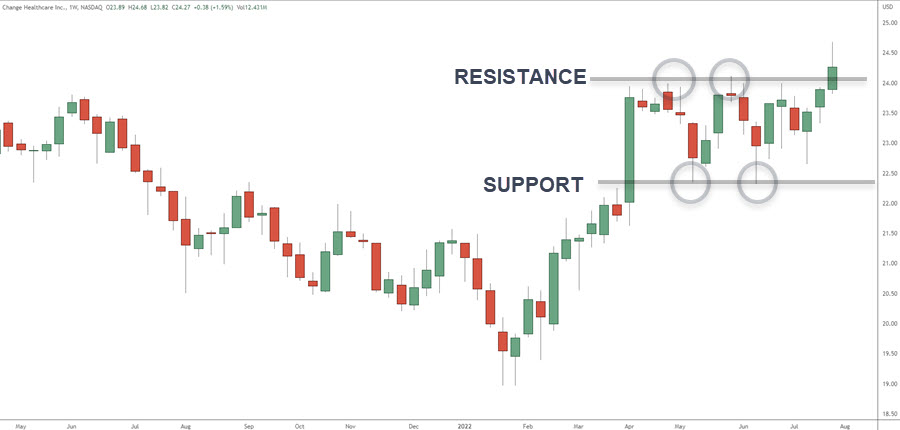 In addition, you will want to look for a stock that has made at least two clear swing highs and two swing lows to confirm support and resistance levels. This is how the horizontal channel forms.
In addition, you will want to look for a stock that has made at least two clear swing highs and two swing lows to confirm support and resistance levels. This is how the horizontal channel forms.
Finally, some traders will make sure that the volume is relatively low during the presence of the channel prior to a breakout.
 This is an indication that there is not a lot of interest in the stock and that price is likely to continue trading within the channel that has formed
This is an indication that there is not a lot of interest in the stock and that price is likely to continue trading within the channel that has formed
Top Trading Strategies For Swing Trading With Horizontal Channels
There are a number of different trading strategies that you can use when swing trading this pattern. The best strategy for you will depend on your own personal preferences and risk tolerance.
However, these are some of the most popular strategies that traders use.
Channel Breakout Strategy
You can wait for the price to break out of the horizontal channel and then enter a position in the direction of the breakout. For most breakouts, traders will want to enter price breaks in the direction of the current trend and avoid counter trend trading. Often times, a trader will use a pending order to accomplish this.
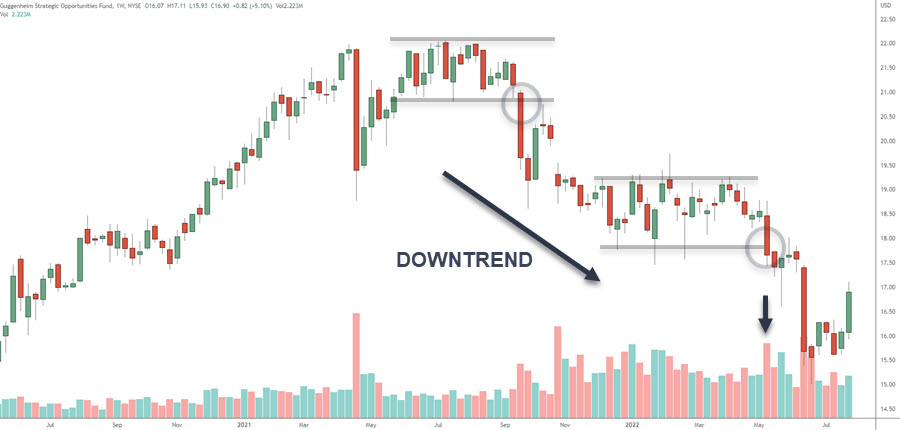
The first breakout on the left comes when the instrument is transitioning from an uptrend to a downtrend. The large red candle with enormous volume can give a trader permission to short another move to the downside.
On the right, we have another breakout with increased volume. However, if you have a pending order to short at the break, you’d be doing so without seeing the increase in volume. To counter this, many traders will wait for the breakout and then use a lower time frame to enter the trade.
Lower Timeframe Entry
This is a one hour time frame and the daily chart had an obvious channel. Price broke out at the open and a trader would wait until the first 30 minutes/60 minutes elapsed. Traders would then enter when price continues to the upside.

Understand that there will be times the breakout fails, called a false breakout, and price will return back inside the price range. That is just the nature of the market and traders have to accept that you may need a few breakout attempts before price takes off.
Breakout And Retest Strategy
You can also wait for the price to retest the horizontal channel after a breakout. To be exact, this is better described as a pullback strategy since that is what we are really trading. This strategy can be used to enter a long or short position.
Price is in an overall uptrend and a horizontal channel forms after price had pulled back as seen on the left side of the chart. We get a breakout and the candle with the arrow is not touching the resistance line. This validates a breakout in my books when looking for a pullback. I don’t consider a breakout to be one unless there is at least one candle not touching the resistance zone (for a long trade).
Price pulls back into the zone without momentum (this is vital). Inside bars sets up as an entry trigger as does a typical reversal candlestick. Traders would buy stop the high or manually enter once price starts to break back to the upside.
Trading The Range
I’m not going to cover trading inside the range as I’ve written a complete tutorial on trading ranges inside this blog.
Placing A Protective Stop Loss
When using a horizontal channel breakout or retest strategy, it is important to place a stop loss order. This will help to protect your capital in case the price reverses direction and moves back into the horizontal channel and especially out the other side. Price coming back into the range does not invalidate the breakout unless momentum accompanies it or price just stalls.
A good rule of thumb is to place your stop loss order just below the support level for a long position, or just above the resistance level for a short position.
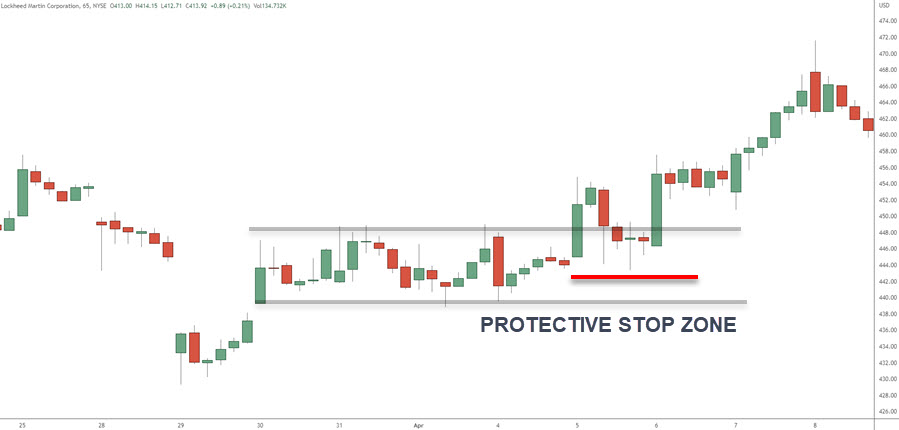
If you decide to use the breakout and pullback trading strategy, you may decide to place your stop loss under the reversal pivot where you see the red horizontal line.
No matter what strategy you trade, you must have a price zone you will exit at if the trade goes against you. Do not let losing trades become trading account killers.
When To Take Profits When Trading Breakouts
Another important consideration when trading is when to take profits.
One option is to set a profit target at the next level of resistance or support. This will help to ensure that you are able to lock in some profits in case the price reverses direction.
Another option is to use a multiple of your risk amount. For example, exiting the trade at 1-3 times your risk is a popular way to exit. However, there are exceptions to this rule and sometimes (especially in volatile markets) it may be prudent to take profits sooner especially if you see strong moves against your position.
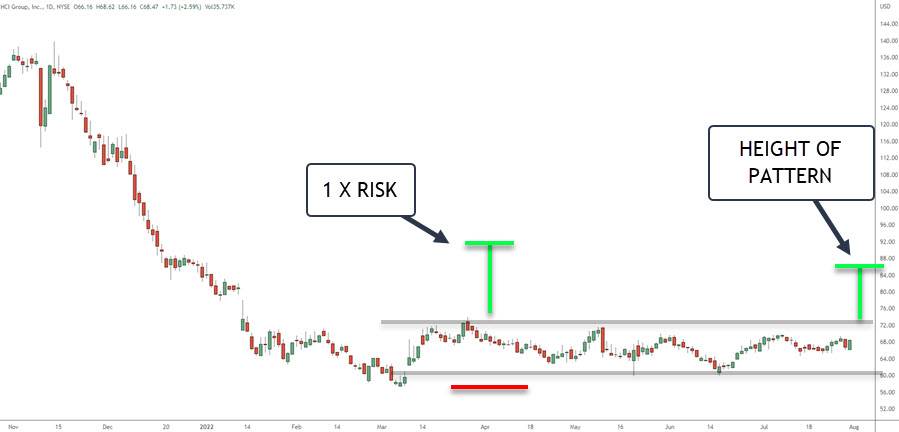 Or, you can simply use the height of the channel and project that from the breakout area to find a profit target.
Or, you can simply use the height of the channel and project that from the breakout area to find a profit target.
If you’re unsure about when to take profits in a particular situation, it’s always best to err on the side of caution and take them sooner rather than later.
Summary
Horizontal channels can provide a great opportunity for traders to enter into profitable positions. However, it is important to remember that there is always risk involved in trading and to never risk more than you are comfortable with losing.
With channels, you have a defined entry point which is something that can prevent you from trading with emotions. Either price breaks the level or it doesn’t. There is no guesswork or indicators needed.
When trading horizontal channels, be sure to place a stop loss order and take profits when the price reaches whatever you’ve outlined as your take profit strategy. By following these simple rules, you can increase your chances of success when swing trading with horizontal channels.

